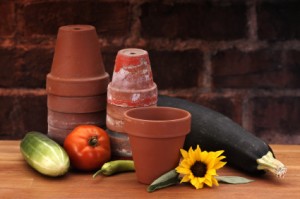 Many of us survival gardeners are fortunate enough to have land—land we can plant and not have to worry about space. But, many people interested in survival gardening aren’t so lucky. They may live in the city, where they have very small plots of land. Or worse, they may only have a patio or balcony to garden from. I’m here to say, never fear, you too can be a survival gardener. Container gardening is definitely an option to those of you with limited space!
Many of us survival gardeners are fortunate enough to have land—land we can plant and not have to worry about space. But, many people interested in survival gardening aren’t so lucky. They may live in the city, where they have very small plots of land. Or worse, they may only have a patio or balcony to garden from. I’m here to say, never fear, you too can be a survival gardener. Container gardening is definitely an option to those of you with limited space!
In this article, I’ll highlight some of the main guidelines to follow when it comes to container gardening. It’s really not as hard as it may seem, and if done correctly, you’d be surprised how many fruits and vegetables you can grow for you and your family. Here are the basics:
- I would highly suggest using terra cotta pots. These pots are very porous and allow for excess water to be absorbed, so that if you do overwater, the pot itself can act as a water storage unit for your plant to draw on once it’s thirsty again.
- Be sure to use pots with proper drainage on the bottom. Because your plants are in containers and not in the ground, excess water is not leached away (and the pot can only absorb so much). Having proper drainage is vital to preventing root rot and promoting healthy growth.
- Use very rich potting soil—organic is a must! Again, because your plants are in containers, they can only draw on the nutrients available in the soil contained in the pot. Get soil rich in organic matter and don’t pack it too tightly.
- When fertilizing, not only should you use an organic fertilizer (such as Protogrow), but you should only use half of the recommended dose when it comes to container gardening. Even though organic fertilizers are lower in nitrogen and less likely to cause fertilizer burn, you still want to only use half dose because the fertilizer will not be able to leach into surrounding soil (because it’s not there!).
- Be sure to use a pot that is big enough for whatever plant you are planting. Most fruits and vegetables are used to a lot of “leg-room”, so when container gardening, you need to accommodate these plants or else they may never reach maturity due to the tight confines. If you find you need a larger pot, simply transplant to a larger one.
- And my last big piece of advice is to not overwater. Keep an eye on your plants and learn to listen to what they’re telling you. If they look droopy, then chances are they’re thirsty. It’s better to underwater than overwater. Eventually you’ll learn to tell when your plants need more water and when they’re satiated.
Obviously every plant is different, so be sure to do your research when starting a container garden. You may want to try herbs first and other easy to grow in container plants such as lettuce, onions, strawberries, and tomatoes. Never think it’s impossible—anything is possible—especially when it comes to survival!
______________________________________________________________________
 Off The Grid News Better Ideas For Off The Grid Living
Off The Grid News Better Ideas For Off The Grid Living




